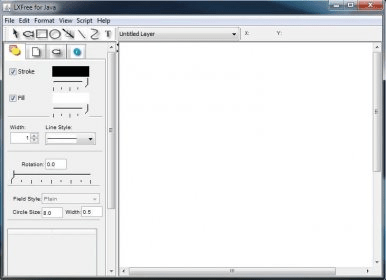
The Open User Library Folder command opens the user library folder in the Finder. Reset Preferences returns all the preferences to the default settings used when the application is first installed. If you modify library files while LXFree is running, the Reload Libraries command will read in the changes. When LXFree starts up, the user and system library folders are scanned for files which are used to create the color, lamp and frame libraries. (The size may be changed later using the Inspector's Document tab.) If a preset size is selected, a new document may include an outline layer if Create outline layer is enabled in the Preferences' Key/Title block tab. New documents are created with the width and height of the drawing area set to that of either the default paper size or one of the preset drawing sizes. (Keys may be loaded into the document from the popup in the Inspector's symbols tab at any time.) If the specified key file is not found, the default key is used. New documents are created with the initial key shown.
MARTIN SYMBOL LXFREE WINDOWS
Restore auxiliary windows when plot is opened re-opens the report, section and model windows that were open the last time a plot was saved. This setting determines how often unsaved documents are autosaved to disk.
MARTIN SYMBOL LXFREE PRO
Any imported PICT graphics in your MacLux Pro plot will need to be copied and pasted into LXBeams.Autosave is a system feature that helps preserve your work in the event the application quits unexpectedly. MacLux Pro does not export external graphics. lxxplot format and the current version of LXFree opens and saves this type of file. MacLux Pro v2.1.8 allows you to export plots in. lxxplot file structure is an XML based format designed to allow cross platform exchange of light plot data. (You may also want to change the title).Ĭan I use LXFree with my existing light plots created with MacLux Pro?. Opening the resulting file in a text editor allows you to find the "" tag and change "cir" to "chan". If you save a report template with a ".lxxreport" extension, it will be saved in an XML based format you can change with a text editor.Īs an example, you can open an "Unused Circuits" report window choose save change the name to "Unused Channels.lxxreport". You can save the template for any report window using the Save command. Reports are created from template files found in the ~/Library/Application Support//reports folder. LXBeams allows you to create and customize reports. For example an "Unused Channel" list rather than unused circuits.

Conversely, you can use the "Remove Unused Entries" command from the popup menu in the Inspector's symbol tab to remove all unused symbols from the current key. When you switch keys, you will not remove any symbols currently in use by the plot. When I load a key, why are there extra symbols showing? This report also allows you to rearrange the order of symbols in the key by dragging their entries. The Symbols report also allows you to rename entries found in the key. LXBeams allows you to edit the information about an entry in the key, including its name. If you want to draw several objects and go back and edit the later, double-click the desired tool to "lock" it (selecting another tool undoes the lock). The tool switches to the selection arrow because the newly created object is selected for editing. The tool keeps switching back to the selection arrow after I draw an object. If snap to grid is off, holding the shift key while dragging a symbol will cause it to snap to a position. As a side note, holding down the shift key will cause the opposite behavior of the snap to grid setting. Dragging along the position rather than off to the side will cause smoother behavior. This may even cause a symbol to jump from one side of the center to another.

The further away from the position, the more a small difference in cursor position will make. Snapping to a position attempts to place the light at the closest snap point in the direction of the cursor. When "Snap to Grid" is selected, light symbols also snap to the spacing of a position. To remove the gobo symbol, select the group, choose ungroup and then select only the gobo symbol and delete it.Ī symbol seems to jump around as I drag it along a position. The insert gobo command is a shortcut that adds a gobo symbol on top of a selected light symbol and groups the two. Then, in LXFree switch to the layer in which you want to place the graphic and choose "Paste". Find the file in the Finder, select it and choose "Copy".

LXFree will import graphic files that are recognized by the operating system: PDF, TIFF, JPG, etc. When I load a key, why are there extra symbols showing?Ĭan I use LXFree with my existing light plots created with MacLux Pro?. Now, how do I remove it?Ī symbol seems to jump around as I drag it along a position.


 0 kommentar(er)
0 kommentar(er)
